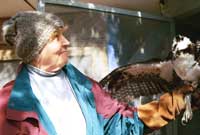Go on beautiful, get out of here,” Emmy Minor says to a brown pelican, its pouch heavy with a load of fresh fish. “Time to fly.”
It’s feeding time at the Sanctuary on Sapelo (SOS), Emmy and Al Minor’s bird rehabilitation center on the Georgia Coast: time to thaw 125 pounds of fish (today it’s thread herring), split the frozen rat carcasses (leftovers from a zoo), and dice up donated beef hearts.
Retirement is not supposed to be like this.

Emmy and an osprey.
Photo: Gail Krueger.
“I’ve got myself into something I can’t get out of,” Emmy says. There’s no end in sight to the birds that need her help, and so Emmy continues to do what she has been doing for 18 years: mending wings, healing gunshot wounds, and slipping antibiotics down unwilling avian throats.
Emmy’s adventures in bird rehabilitation began in 1983, when she and her husband Al turned a good part of their 10 acres of wooded land into a bird sanctuary along the banks of the Sapelo River in rural McIntosh County, the heart of coastal Georgia. McIntosh used to be one of the poorest counties in the state, but its lovely landscapes gradually attracted developers, who have carved mini-estates out of the piney woods and built McMansions cheek-by-jowl along the estuaries. Similar developments are sweeping up and down the entire coast of Georgia, turning many local birds into refugees. The more people that migrate to the area, the more birds — pelicans, red-tailed hawks, ospreys, owls, and eagles — find their way into Emmy’s care.
“I’d say 99 percent of the birds we see have had some sort of run-in with people,” Emmy says. This contact isn’t so much with humans as with the artifacts of humanity: Terns are caught in six-pack rings, pelicans get errant fishhooks snagged in their pouches. Several birds have experienced seizures or lost their sense of balance, which the Minors believe is a consequence of pesticide poisoning or toxic chemical contact. According to Emmy, the worst case she’s seen in the sanctuary was a young eagle with rope tangled around its talon. The eagle flew into SOS, but Emmy and Al were never able to capture it. It died hanging by the rope from a tree branch.
That eagle’s sad plight illustrates both the need for and the limitation of SOS. The Minor’s high-ceilinged, low-slung coastal house is at the end of the road, both literally and figuratively. If an injured bird can’t make it here, it can’t make it, period.
Feathering the Nest
On a typical day at SOS, Al is preparing for the 700-mile roundtrip voyage to St. Petersburg, Fla., to buy more frozen fish. Usually, local fishers and shrimpers donate generously to the Minors and their flock, but last year, most nets along the coast were empty, so Al has been making the trip twice a month.
Emmy, meanwhile, is on the phone giving instructions on how to care for a wayward homing pigeon that someone found. “Yes, you can bring it here, but it probably just needs to rest,” she says. “Offer it some grain and call me back.”

Bird food for thought, delivered by Nan.
Photo: Gail Krueger.
Then it’s off to care for the birds on the premises. About 10 yards from the front porch of the Minor’s home, a large, fenced pen contains a cacophonous assortment of water and wading birds on the mend. Down a path, caged owls and hawks are busy rehabilitating. Elsewhere, an aviary houses three pairs of bald eagles that have been injured so severely they will not be able to return to the wild. The Minors are working with the Georgia Department of Natural Resources to try to induce the birds to reproduce so their offspring can return to nature.
Today, an osprey recovering from a gunshot wound needs to be moved from one cage to another. Five months ago, a veterinarian treated the bird for free before turning it over to SOS. The osprey’s head hangs to one side, but it is recuperating, albeit very slowly.
Nan Page, a veterinary technician from Atlanta, has been working with the osprey every day. “Even ospreys need physical therapy sometimes,” she says. Nan helps Al and Emmy run SOS, taking on some of the heavier work that Emmy and her arthritic knees can no longer handle. Nan spreads her arm wide as if to take in the whole of SOS. “This is her passion,” she says of Emmy.
But Emmy’s passion, and her patience, is wearing thin. “If Al dropped dead tomorrow, I couldn’t hold the funeral until I fed the birds,” she quips. “You know anybody who wants to run this place?”
Nonetheless, Emmy believes that some things are getting better. At the shrimp docks where she begs fish, the dockworkers are picking up their trash these days instead of dumping it into the river. Kids are telling their parents why it’s bad to shoot hawks. Emmy suspects that people also value their surroundings more than they used to. It’s better because some people are more aware, she says, but it’s worse because there are more people.
As the coastal population continues to grow, Emmy hopes people will find room in their hearts for the birds and other wildlife that they are displacing. She hopes her effort to educate people about the value of the native wildlife will outstrip the pace of development, both for the sake of the birds and the people. Otherwise, “I think one day God is going to look down and decide he doesn’t like the way we’ve treated this place, and he’s going to squeeze us out of here,” says Emmy. “The Earth will heal, especially if we’re not around.”

